

Course.oeru. Home. Eduhub. Dimensions of Creativity: Originality. Originality: ability to generate a product or idea that is unique or very unusual, unexpected, first of its kind.
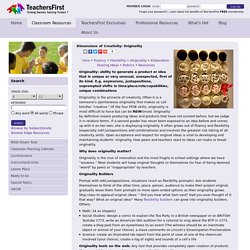
E.g. oxymorons, juxtapositions, unprompted shifts in time/place/role/capabilities, unique combinations Originality is the pinnacle of creativity. Often it is a someone's spontaneous originality that makes us call him/her "creative. " Of the four FFOE skills, originality is most difficult to force but can be REINforced. Originality by definition means producing ideas and products that have not existed before, but we judge it in relative terms. The Learning Partnership - Home.
Churchill. Center for Curriculum Redesign. European Journal of Open, Distance and E-Learning. Peer-reviewed scholarly articles in English can be found at the "Peer-reviewed articles" page and in the respective archive.

Non-refereed articles on project reports, case studies, work in progress, fresh ideas and other contributions that support communication between the EDEN membership and the wider European ODeL community can be found at the "Brief Items" page and the respective archive. Non-English articles are welcome with an abstract in English.
Book reviews can be found at the "Review" page and the respective archive. Subscribers can follow the availability of new journal issues and related news from EDEN by the regular e-mail notification and RSS as well as get access to interactive services such as commenting and discussion board. Athabasca University. Open. Online. Everywhere. : Athabasca University. Students Infographic Archives. Publishing Platform for Documents and Magazines. Red iberoamericana de docentes. The Macmillan Community. Preparing to teach a class is a lot like preparing dinner for friends.
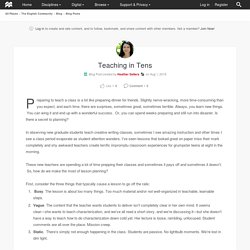
Slightly nerve-wracking, more time-consuming than you expect, and each time, there are surprises, sometimes great, sometimes terrible. Always, you learn new things. You can wing it and end up with a wonderful success. ClassDojo. A Moodle-based eLearning solution. Welcome! Versal. The Gamification of Education Infographic #gamification #edtech. Reading to Learn in Science.
Welcome, Science Teachers!
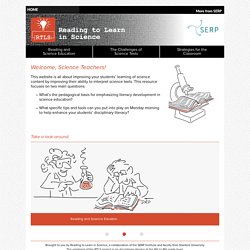
This website is all about improving your students’ learning of science content by improving their ability to interpret science texts. This resource focuses on two main questions: What’s the pedagogical basis for emphasizing literacy development in science education? What specific tips and tools can you put into play on Monday morning to help enhance your students’ disciplinary literacy? Brought to you by Reading to Learn in Science, a collaboration of the SERP Institute and faculty from Stanford University. The emphasis of the RTLS project is on disciplinary literacy at the 4th to 8th grade level. AltSchool. WhatNowEdTech - Home. Blended Learning Definitions. The definition of blended learning is a formal education program in which a student learns: at least in part through online learning, with some element of student control over time, place, path, and/or pace;at least in part in a supervised brick-and-mortar location away from home;and the modalities along each student’s learning path within a course or subject are connected to provide an integrated learning experience.
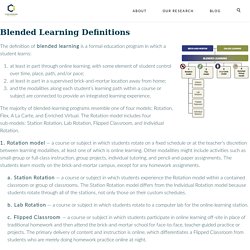
The majority of blended-learning programs resemble one of four models: Rotation, Flex, A La Carte, and Enriched Virtual. The Rotation model includes four sub-models: Station Rotation, Lab Rotation, Flipped Classroom, and Individual Rotation. 1. Animated Explanations by Funk-e. Think. Learn. Innovate. Free Simulation and Modeling in your Browser. Higher Education News, Career Advice, Jobs. Home. Home - TERC Home. Learn Your 24 Character Strengths: VIA Character Survey. Each one of us possess all 24 of the VIA character strengths in varying degrees making up our own unique profiles.
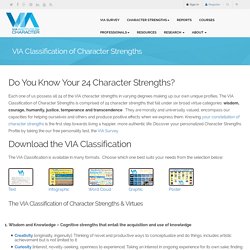
Education – Hypothesis. The Internet, peer reviewed. Resource-Based Learning. Lisa Campbell, Paula Flageolle, Shann Griffith, Catherine Wojcik Department of Educational Psychology and Instructional Technology, University of Georgia Review of Resource-Based Learning Introduction Scenario Mr.
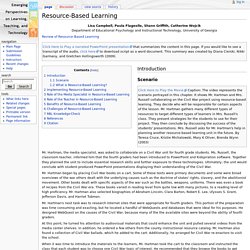
Hartman, the media specialist, was asked to collaborate on a Civil War unit for fourth grade students. Mr. Mr. Teach Students to Ask Their Own Questions. This process explicitly validates all students’ intellectual abilities.– High School History Teacher, New York The reasons behind their questions often bowl me over with their sincerity, the fact that [they] really want to know the answers because it’s important to them, or they feel it would be important for others to know.– 4th Grade Teacher, Chicago The ability to produce questions, improve questions and prioritize questions may be one of the most important—yet too often overlooked—skills that a student can acquire in their formal education.
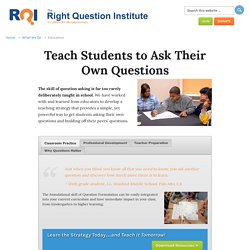
Strong critical thinking is often grounded in the questions we ask. By deliberately teaching questioning skills, we will be facilitating a process that will help students develop a mental muscle necessary for deeper learning, creativity and innovation, analysis, and problem solving. Join the Movement: Make Question Formulation a part of Every Child’s EducationGet Involved » Are We Asking the Right Questions. Ed.review. K-12 Formative Assessments, Homework, Videos, Lesson Plans. Farafina Trust - A non-profit organization established to promote reading and writing. Learning, education and community.
Featured Updated: What is a group?

In this article we review the development of theory about groups. Digital Image Archive of Medieval Music. Learn to solve any problem with a simple picture. Dumbing Us Down - The Hidden Curriculum of Compulsory Schooling. 1.

Confusion: I teach too much, and everything that I teach is out of context. The orbiting of planets, the law of large numbers, slavery, adjectives, architectural drawing, dance, assemblies, etc. Editors note: I have met countless college graduates whose heads are filled with volumes of academic jumble, but who cannot focus, live under constant stress, can't make a decent income, and can't maintain a stable relationship with a member of the opposite sex. 2.Class Position: I teach students that they must remain in the class into which they were born, the class where they belong. If I do my job well, my students will be unable to imagine themselves somewhere else. Symbaloo EDU Español - Educacion virtual.
Con más de 10 millones de usuarios alrededor del mundo, el éxito de Symbaloo continúa creciendo. En 2010, lanzamos SymbalooEDU. The Teachers Guild - Home. MYDOCUMENTA. Pearson - Open Ideas: Pearson Open Ideas Home Page. VISIBLE LEARNING - Information About What Works Best For Learning. John Millner's MAODE blog. How to do Assessment › Assessment Primer › Assessment › University of Connecticut. Assessment to improve learning focuses on how well students are learning what we intend them to learn. By establishing learning objectives, assessment methods are used to measure selected learning outcomes to see whether or not the objectives have been met for the course or program. Ways of gathering evidence (Assessing Student Learning: A common sense guide by Suskie 2004 and Assessing for Learning: Building a sustainable commitment across the institution by Maki 2004) A summary of Direct Assessment Techniques (2 page.
The Assessment Learning Cycle › Assessment Primer › Assessment › University of Connecticut. Assessment Cycle Promoting Institutional Effectiveness Student Learning Assessment Cycle Successful assessment requires articulating goals Goals for learning – express intended results in general terms. Used to describe broad learning concepts; e.g., clear communication, problem solving, and ethical awareness. Objectives for learning – express intended results in precise terms. An Annotated List of Flipped Class Tools and Resources – Turn to Your Neighbor: The Official Peer Instruction Blog. Flipped Class Tool and Resource List from Turn to Your Neighbor We will keep a (clearly very incomplete) list of tools and resources we use and/or discover relative to flipped teaching here. Help us grow this list using the form at the bottom of the page. We try to emphasize free tools on this page.
There are many paid, inexpensive tools that we are big fans of including Screenflow (screencasting software) and Learning Catalytics (classroom response and assessment system). Jigsaw: CTLE Resources. What is the Jigsaw Activity? A Jigsaw Activity is one that involves all students in the creation and sharing of knowledge independent of the instructor. The instructor is available to provide support and make sure all students are on task, but the responsibility for both teaching and learning belongs to the students. Jigsaw requires two rounds of student grouping. In the initial grouping, students are given some resources (e.g., text, formula, etc.) and charged with getting to know certain information on a particular topic, solving a particular problem or responding to a set of question. Each group has unique information with which to work.
Problem-Based Learning: CTLE Resources. What is Problem-Based Learning (PBL)? Problem-Based Learning (PBL) is another approach to learner-centered instruction. The instructor (or tutor in PBL-speak) is a facilitator for the learning process, but the entire execution of the PBL experience is student-led. PBL engages students because the real-world problems are determined by student interest and explored in ways the students suggest. The situations they are dealing with are complicated and target student's analytical, critical thinking and problem-solving skills.They are deliberately ambiguous so students have to work hard to arrive at solutions and often they are so multifaceted, that arriving at a solution can present yet another problem to be addressed.
The experiential nature of PBL is underscored by the fact that the students have to think and act like real professionals in their respective fields as they work to solve realistic problems. Team-Based Learning (TBL): CTLE Resources. Active Learning: CTLE Resources. Center for Educational Innovation.